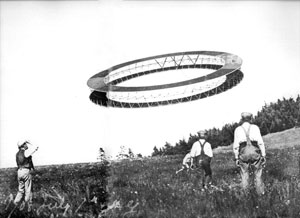

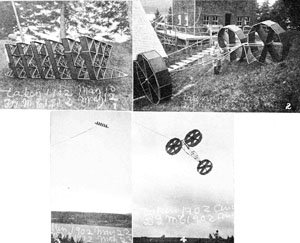
Archives
July 2007 August 2007 October 2007
Subscribe to Posts [Atom]
Bell Kite Project Blog
I am building a huge kite inspired by Alexander Graham Bell's historical models.Recap
Sunday, August 26, 2007
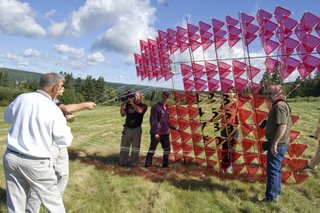
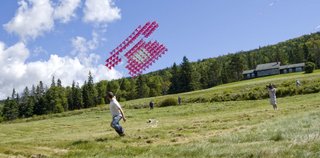
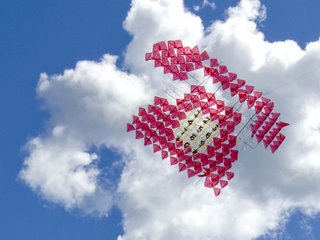
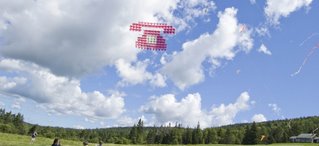 I'm now back in Toronto and have time to fill in some of the details of the kite fly.
I'm now back in Toronto and have time to fill in some of the details of the kite fly.Eileen and I drove the kite out to Baddeck, NS last week. The kite folds up like an accordion, so we were able to make it fit in the back of a rental car.
On Monday we meet the other kite fliers who were attending the Cygnet Centennial. We toured the Bell Museum in Baddeck together and a couple people including Bell's grandson gave historical talks about Bell's kites, especially the amazing Cygnet kite that achieved manned flight a hundred years ago. I noticed that no one pointed out that Bell's kite designs, though beautiful and unique, in fact weren't very successful and that the Aerial Experimentation Association that he formed moved to flying airplanes of much more conventional design.
That evening there was a dinner at the Museum and we socialized with the kite fliers. There were lots of world-famous kite personalities there, so I felt pretty out of place. It's fun to meet people from another subculture, though I felt a little like an impostor. It also felt a little strange that I had been getting all the phone calls from the CBC to do interviews when I knew the least about kites of anyone there.
On Tuesday morning we drove out to the Bell estate to fly the kite. The estate is a picturesque peninsula peppered with the houses of Bell descendants. They range from modest homes, to castles, to remodelled historical workshops. We were instructed to set up the kite in a field that looked lovely but turned out to be a black fly breeding swamp. Our feet were soaked and the blood was flowing from bug bites that morning as we laboured to assemble the kite in time for the short window in which we were scheduled to fly the kite.
After a while the rest of the kite fliers showed up and immediate launched their collection of beautiful kites. I was impressed at how efficient they all were, and how they could fly their kites so close to each other without tangling lines.
Once the telephone kite was finally assembled we were faced with the task of trying to bridal it. Bridling is the tricky process of attaching the kite line to the kite via a collection on intermediary lines. A kite's ability to fly depends in great measure on the soundness of its bridling. I had some vague ideas of how it might be bridled and so we attempted to get it off the ground using my makeshift bridal. The kite flew for a few seconds and I slipped in the muck and fell down while running with it.
Eileen was able to convince some of the expert kite fliers to help us improve the bridle. I should add that this was a mighty imposition, since it meant having to give up a unique chance to fly their own kites on this historic spot. To my surprise, there was considerable controversy and not a little acrimony in the matter of how to bridal my kite. However in the end, Bas Vreeswijk got it working.
Now we were able to achieve a few flights of around 30 seconds to a minute by dint of running and letting out line. Unfortunately there remained the problem of a giant knot in my kite line. The patient Michaela Koch led us through the process of untangling the problem.
We had now fixed most of the serious technical problems with the kite, however most of the other folks had packed up. The wind picked up and we flew the kite a final time with great success. One workers from the Bell Estate who had been helping us manned the line and managed to get the kite well up in the air and keep it there for a couple minutes.
There was an abbreviated trip to the Bell mansion and then we returned to the soggy field to dismantle the kite and pack it back into the rental car.
I should also add that during the entire hectic event there were several TV crews and a number of press photographers shadowing us and impatiently waiting for the kite to take flight. I gave a few interviews, though I'm not exactly sure who I was being interviewed by. By chance, that evening we heard an interview on the CBC radio while driving back. Normally I cringe when hearing myself on the radio, but I was surprised at how decent it sounded and how they were able to convey the humour of the event without ridiculing it.
After a couple days journey I'm back in Toronto. I'm not sure where the kite will go next. There's a possibility of displaying it in a children's museum, as well as flying it at the University of Waterloo. Right now it's resting in my basement.
Comments:
<< Home
I know this is a little after the fact, but have you seen the giant floating banana? it is kind of like a big kite...http://www.geostationarybananaovertexas.com/en.html
What a great outcome to a fascinating experiment - not only that, but it's shaped like a f-ing PHONE floating in the sky!? That's a little daring because I would think you're losing a lot of potential lift with those empty cells. I've tried to fly this exact same pyramid shape (with only 4 cells) and could never get it to fly - I think it's all about the bridle.
Well Done! Pop the cork A-man, here's to Alex B.....
Post a Comment
Well Done! Pop the cork A-man, here's to Alex B.....
<< Home

